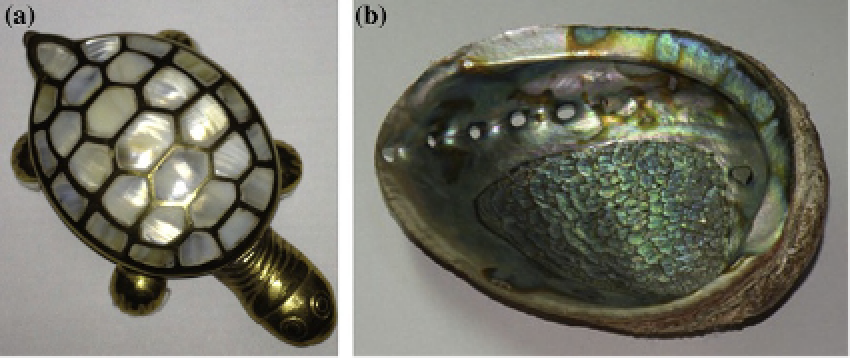Biomedical Engineering Reference
In-Depth Information
thickness (via swelling) or by varying the space
between the platelets. Tilting the platelets
changes the incidence angle of light and the
wavelength of selective reflection
[122]
. Artifi-
cial structures with color tunability have been
fabricated as multilayer high- and low-refrac-
tive-index organic/inorganic films (titania pre-
cursor sol and a polymer solution), in which the
color can be tuned through the interlayer dis-
tance or the refractive index
[122]
. Tunable color
has also been demonstrated by swelling of opal
composites
[123]
. Such changes are potentially
useful for colorimetric sensors of humidity, ten-
sion, and strain
[122]
.
China; the wings of jewel beetles and the feathers
of birds were used for decoration in Japan more
than a thousand years ago. Mica powder was
used in cosmetics as well as in the Japanese art
form
Ukiyo-e
in the 17th and 18th centuries
[11]
.
Nacre or mother of pearl is still used to decorate
objects, such as the box depicted in
Figure 11.24
.
The use of paua shells, one of which is shown
in
Figure 11.24
, for jewelry has spread from the
Maori culture in New Zealand to many parts
of the world. Modern art benefits from the bril-
liant colors of
Morpho
and other butterflies, often
bred in butterfly farms
[124]
, by incorporating
their wings in works of art, as exemplified by
Figure 11.16
.
11.6 APPLICATIONS OF
STRUCTURAL COLORS IN ART
AND INDUSTRY
11.6.2 Industrial Applications
of Structural Colors
The burgeoning interest in structural colors
during the last two decades is fed by the pos-
sibilities of creating synthetic photonic struc-
tures that mimic natural photonic structures as
well as new materials for coatings and fabrics,
cosmetics, and paints
[11, 94]
. Industrial appli-
cations require implementation of simple, fast,
efficient, and inexpensive techniques allow-
ing production of a variety of shapes and sizes
with guaranteed repeatability and quality. Most
engineered-biomimicry approaches to fabricat-
ing structural colors discussed heretofore in this
11.6.1 Structural Colors and Art
The applications of structural colors for art and
decoration come naturally because iridescent
sheen, pearly luster, and play of colors are fas-
cinating. For thousands of years, they have been
a part of our lives as decorations satisfying our
aesthetic needs and signifying social status.
Opals and pearls have special value in jewelry.
Pearlescent laminae of ear shell or turban shell
have been used to decorate lacquerware in
FIGURE 11.24
(a) An ornamental tortoise made of a metal and mother of pearl. (b) A paua shell from New Zealand.



